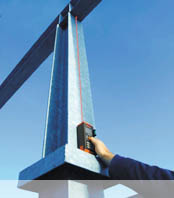|
||||||||||||||||||||||||||||||||||||
Frequently asked questions |
|||||
|
Questions: |
|||||
|
Does the DLE 150 automatically recognize which end piece is used? |
|||||
|
What does laser class 2 mean? Is the laser beam harmful to the eyes? |
|||||
|
Does the DLE 150 always measure correctly? Before each measurement the DLE 150 makes a control measurement (reference measurement in the device). Only if this is correct, a result will be shown. Therefore, the device either shows a correct result (within the scope of the specified measuring accuracy) or no result at all. Due to the mechanical switching to the reference measurement there is a clicking noise which can be heard when pressing the measurement button. |
|||||
|
Does the DLE 150 automatically recognize which end piece is used? The DLE 150 automatically recognizes whether the compact or the universal end piece is used and adjusts the lengths according to the end piece used while measuring. In order to exclude possible errors, the measurement is always made from the rear end of the device. |
|||||
|
What is the difference between DLE 150 and the DLE 60? The DLE 150 measures further, faster and more accurate than its predecessor. Reasons for this are new optics and new powerful electronics. Further functions and supplement equipment in contrast to the DLE 60: min-max function, addition and subtraction function, memory, continuous pointer mode, aligning aid, 1/4 threads, vial, rubber puffer at front and rear edge, protective bag with removable cover, compact and universal end piece. Moreover, the DLE 150 is smaller and lighter than its predecessor. |
|||||
|
Do dust, fog, rain, smoke or wind cause innacuracy? Dust, fog, rain or smoke consist out of small particles or droplets. When they are hit by the laser point, light is reflected to the device and can interfere with the measurement. |
|||||
|
Which influence do sun light / bright light have? Sunlight complicates measurements of a laser rangefinder. The reason is that the brightness of the ambient light becomes more and more similar to the brightness of the laser beam. When there is strong ambient light, the use of the target panel is recommended. However, the DLE 150 is so powerful that for the majority of the measurements a target panel is not necessary. |
|||||
|
Can I measure through water or glass? Reliable measurement through water or glass is not possible, since all surface boundaries (e.g. water or glass surface), which are passed by the laser beam, reflect light to the device. |
|||||
|
Can I use the DLE 150 also at low temperatures? The DLE 150 can also be used at low temperatures. Generally the device can be used from -10 °C up to 50°C. If mainly used under 0°C use of NiCd or NiMH rechargeable batteries is recommended. |
|||||
|
What does laser class 2 mean? Is the laser beam harmful to the eyes? Devices of laser class 2 are considered safe for the eyes. The normal eye-shut-reflex of the human eye is sufficient in protecting it. All BOSCH measuring tools correspond to the laser class 2. |
|||||
|
Is the device protected against explosion? In explosion-endangered areas (e.g. refinery or chemical factory) it is only permitted to work with devices that have a certificate for explosion protection. The DLE 150 does not have a certificate because use in these areas is not intended. |
|||||
 |
|
|
Small, light, handy |
|
 |
|